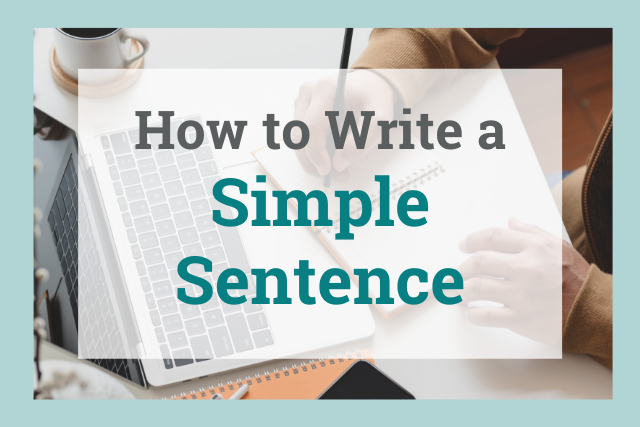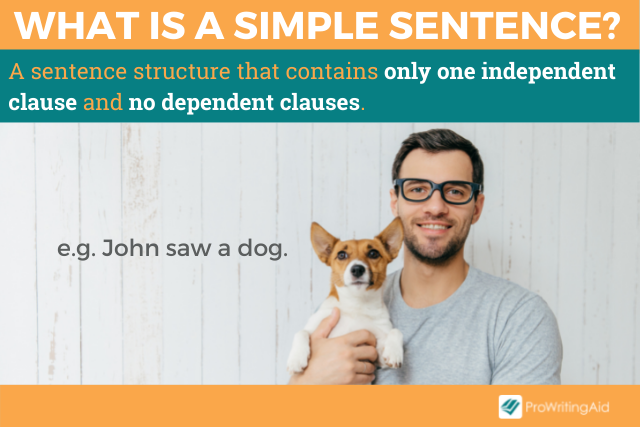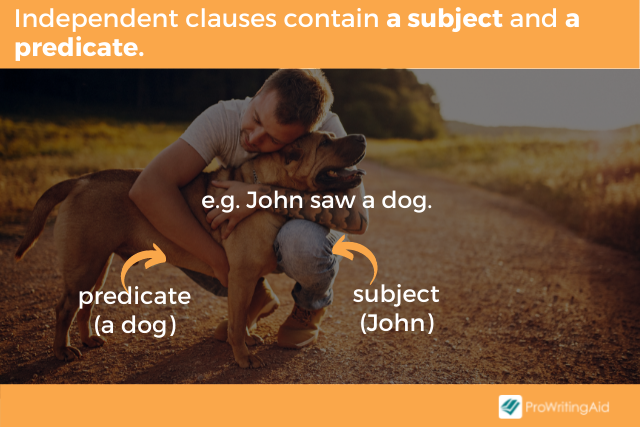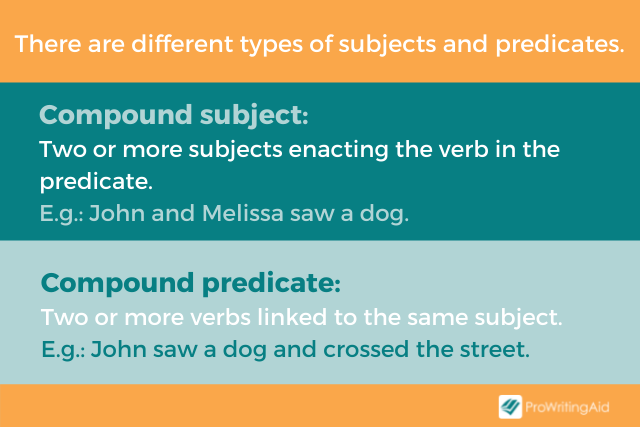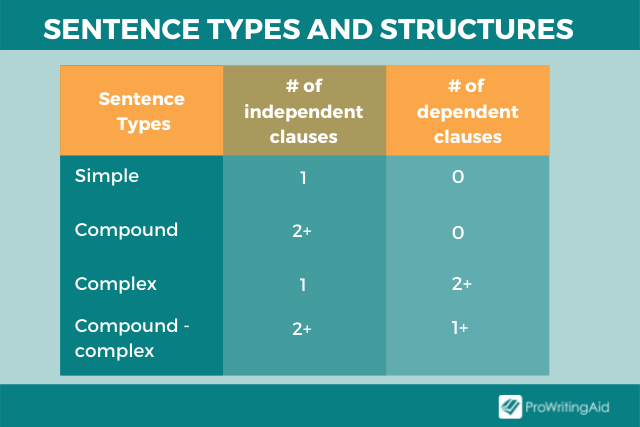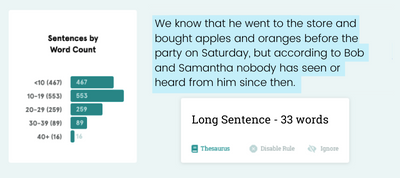We all know what sentences are, but do you know the different types of sentence structures and how to form them? There are four different types of sentences in English; simple sentences, compound sentences, complex sentences, and compound-complex sentences. This explanation is all about simple sentences, a complete sentence that consists of a single independent clause, typically containing a subject and a verb, and expressing a complete thought or idea.
Keep reading to find out more (p.s that’s a simple sentence!)
Simple sentence meaning
A simple sentence is the simplest type of sentence. It has a straightforward structure and consists of only one independent clause. You use simple sentences when you want to give direct and clear information. Simple sentences communicate things clearly because they make sense independently and don’t have any additional information.
Clauses are the building blocks of sentences. There are two types of clauses: independent and dependent clauses. Independent clauses work on their own, and dependent clauses rely on other parts of the sentence. Every clause, independent or dependent, must contain a subject and a verb.
Simple sentence structure
Simple sentences only contain one independent clause, and this independent clause must have a subject and a verb. Simple sentences can also include an object and/or a modifier, but these aren’t necessary.
A simple sentence can contain multiple subjects or multiple verbs and still be a simple sentence as long as another clause is not added. If a new clause is added, the sentence is no longer considered a simple sentence.
Simple sentence: Tom, Amy, and James were running together. Not a Simple Sentence: Tom, Amy, and James were running together when Amy sprained her ankle and Tom carried her home.
When a sentence contains more than one independent clause, it is considered a compound sentence. When it contains an independent clause with a dependent clause, it is regarded as a complex sentence.
Simple sentence examples
Some examples of the simple sentence include:
-
John waited for the taxi.
-
Ice melts at zero degrees celsius.
-
I drink tea every morning.
-
The children are walking to school.
-
The dog stretched.
The subject and verb have been highlighted
Did you notice how each example sentence only gives us one piece of information? No extra information has been added to the sentences using extra clauses.
Now that we’ve seen some examples of simple sentences, let’s look at a piece of text where simple sentences are used frequently. Remember, in imperative sentences, the subject is implied. So, the sentence ‘Heat the oven to 200 degrees Celsius‘ actually reads as ‘(You) heat the oven to 200 degrees Celsius‘.
Take a look; can you spot all the simple sentences?
Cooking Instructions:
Heat the oven to 200 degrees Celsius. Start by weighing the flour. Now sieve the flour into a large bowl. Measure out the sugar. Mix together the flour and sugar. Create a dip in the dry ingredients and add the eggs and melted butter. Now mix all the ingredients together. Whisk the mixture until fully combined. Pour the mixture into a cake tin. Cook for 20-25 minutes. Let it cool before serving.
Below, we can see how many simple sentences there are in this text:
- Heat the oven to 200 degrees Celsius.
- Start by weighing the flour.
- Now sieve the flour into a large bowl.
- Measure out the sugar.
- Mix together the flour and sugar.
- Now mix all the ingredients together.
- Whisk the mixture until fully combined.
- Pour the mixture into a cake tin.
- Cook for 20-25 minutes.
- Let it cool before serving.
You can see that the majority of sentences in this text are simple. Instructions are a great example of when simple sentences can be helpful, as shown in the example above. Simple sentences are direct and clear — perfect for giving informative instructions that are easy to understand.

Let’s think a bit more about why we use simple sentences, both in writing and in spoken language.
Types of simple sentences
There are three different types of simple sentences; single subject and verb, compound verb, and compound subject. The type of sentence it is depends on the number of verbs and subjects the sentence contains.
Single subject and verb simple sentences
As the name suggests, single subject and verb simple sentences contain only one subject and one verb. They are the most basic form of a sentence.
- The cat jumped.
- The black dress looks nice.
- You must try.
Compound verb simple sentences
Compound verb simple sentences contain more than one verb within a single clause.
- She jumped and shouted with joy.
- They walked and talked the whole way home.
- He bent down and picked up the kitten.
Compound subject simple sentences
Compound subject simple sentences contain more than one subject within a single clause.
- Harry and Beth went shopping.
- The class and the teacher visited the museum.
- Batman and Robin saved the day.
When to use simple sentences
We use simple sentences all the time in both spoken and written language. Simple sentences are used when we want to give a piece of information, give instructions or demands, talk about a single event, make an impact in our writing, or when speaking to someone whose first language is not the same as our own.
In a more complex text, simple sentences should be balanced out with other sentence types, as a text would be considered boring if it only contained simple sentences. This is the same with every sentence type — no one would want to read something where all the sentences are of a similar structure and length!
How to identify simple sentences
We use clauses to identify a type of sentence. In this case, simple sentences contain only one independent clause. These sentences are usually quite short and do not contain additional information.
Other types of sentences contain a different amount of independent and dependent clauses:
-
A compound sentence contains two or more independent clauses.
-
A complex sentence contains at least one dependent clause alongside an independent one.
-
A compound-complex sentence has at least two independent clauses and at least one dependent clause.
We can therefore identify each sentence type by deciding whether a dependent clause is used and by looking at the number of independent clauses that the sentence contains. But remember, when it comes to simple sentences, we are only looking for a single independent clause!
The dog sat down.
This is a simple sentence. We know this as we can see there is one independent clause that contains a subject and a verb. The short length of the sentence further indicates that it is a simple sentence.
Jennifer decided she wanted to start scuba diving.
This is also a simple sentence, even though the clause is longer. Because the length of sentences varies, we rely on the type of clause to identify different types of sentences.

Simple Sentence — Key takeaways
-
A simple sentence is a type of sentence. The four types of sentences are simple, compound, complex, and compound-complex sentences.
-
Simple sentences are formed using an independent clause. Clauses are the building blocks for sentences, and independent clauses work on their own.
-
Simple sentences are direct, easy to understand, and clear about their information.
-
Simple sentences must contain a subject and a verb. They can optionally also have an object and/or a modifier.
The
simple sentence is a sentence in which only one predicative line is
expressed.
1.
According to their structure all
simple sentences of English should be divided into two-member
(two-axis) constructions and one-member (one-axis)
constructions
(Fig.
112).
One-member
and two-member sentences are distinguished by the number of
principal parts (positions) they contain: two-member sentences have
two main parts – the subject and the predicate, while one-member
sentences have only one principal part, which is neither the
subject nor the predicate.
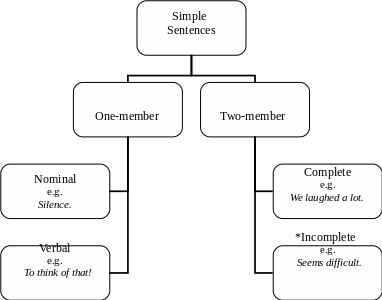
Fig.
112
One-member
sentences in English are of two types:
nominal
sentences and
verbal
sentences. Nominal sentences are those in which the principal part is
expressed by a noun. They state the existence of the things expressed
by them. They are typical of descriptions. Verbal sentences are those
in which the principal part is expressed by a non-finite form of the
verb, either an infinitive or a gerund. Infinitive and gerundial
one-member sentences are mostly used to describe different emotional
perceptions of reality.
Two-member
(two-axis) constructions can be complete
and
incomplete. They are distinguished by the presence or absence of
word-forms in the principal positions of two-member sentences.
In a complete sentence both
the principal positions are filled with word-forms.
In an
incomplete (elliptical) sentence one or both of the main positions
are not filled, but can be easily supplied as it is clear from the
context what is missing.
Elliptical
sentences are typical of conversational English. There exist several
types of elliptical sentences (Fig.
113).
Fig.
113
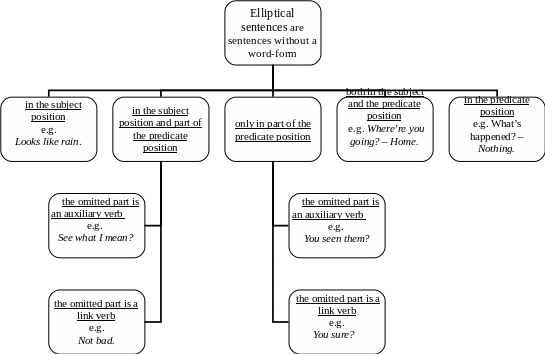
Fig.
114
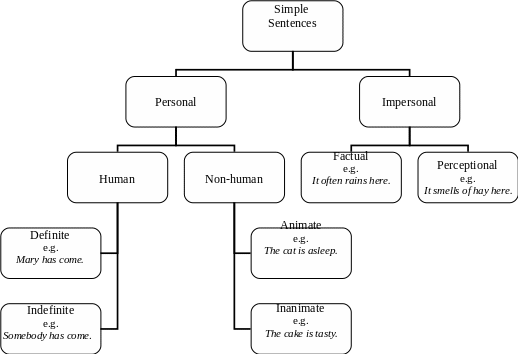
The
semantic classification of simple sentences should be effected at
least on the three bases: first, on the basis of the subject
categorial meanings; second,
on the basis of the predicate
categorial meanings; third,
on the basis of the subject-object
relation.
2.
According to the type of the subject
simple sentences are divided into personal and impersonal (Fig.
114).
The further division of the personal sentences is into human and
non-human; human —
into
definite and indefinite; non-human —
into
animate and inanimate. The further essential division of impersonal
sentences is into factual and perceptional. The differences in
subject categorial meanings are sustained by the obvious differences
in subject-predicate combinability.
3.
According to the type of the predicate simple
sentences are divided into process-featuring (“verbal”) and, in
the broad sense, substance-featuring (including substance as such and
substantive quality —
“nominal”)
(Fig.
115).
Among the process-featuring sentences actional and statal ones are to
be discriminated. Among the substance-featuring sentences factual and
perceptional ones are to be discriminated.
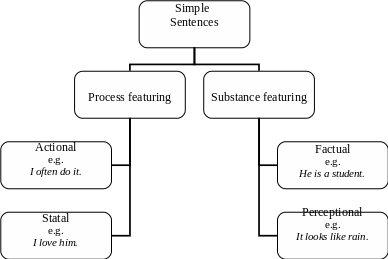
Fig.
115
4.
According
to the type of the subject-object relation
simple
sentences should be divided into subjective, objective and neutral or
“potentially” objective, capable of implying both the transitive
action of the syntactic person and the syntactic person’s
intransitive characteristic (Fig.
116).

Fig.
116
5.
According to the presence of secondary parts simple
sentences should be divided into unextended
(unexpanded) and extended
(expanded)
(Fig.
117).

Fig.
117
An
unextended
sentence contains two main positions of the basic pattern, that of
the subject and the predicate.
An extended
sentence may contain various
optional
elements (including attributes, certain kinds of prepositional
objects and adverbial modifiers).
Соседние файлы в предмете [НЕСОРТИРОВАННОЕ]
- #
- #
- #
- #
- #
- #
- #
- #
- #
- #
- #
A technology that strives to understand human communication must be able to understand meaning in language. In this post, we take a deeper look at a core component of our expert.ai technology, the semantic disambiguator, and how it determines word meaning and sentence meaning via disambiguation.
To start, let’s clarify our definitions of words and sentences from a linguistic point of view.
Word Meaning and Sentence Meaning in Semantics
Semantics is the study of the meaning of words, phrases, sentences and text. This can be broken down into subcategories such as formal semantics (logical aspects of meaning), conceptual semantics (cognitive structure of meaning) and today’s focus of lexical semantics (word and phrase meaning).
A “word” is a string of characters that can have different meanings (jaguar: car or animal?; driver: one who drives a vehicle or the part of a computer?; rows, the plural noun or the third singular person of the verb to row?). A “sentence” is a group of words that express a complete thought. To fully capture the meaning of a sentence, we need to understand how words relate to other words.
Going Back to School
To understand word meaning and sentence meaning, our semantic disambiguator engine must be able to automatically resolve ambiguities with any word in a text.
Let’s consider this sentence:
John Smith is accused of the murders of two police officers.
To understand the word meaning and sentence meaning in any phrase, the disambiguator performs four consecutive phases of analysis:
Lexical Analysis
During this phase, the stream of text is broken up into meaningful elements called tokens. The sequence of “atomic” elements resulting from this process will be further elaborated in the next phase of analysis.
- John > human proper noun
- Smith > human proper noun
- is > verb
- accused > noun
- of > preposition
- the > article
Grammatical Analysis
During this phase, each token in the text is assigned a part of speech. The semantic disambiguator can recognize any inflected forms and conjugations as well as identify nouns, proper nouns and so on.
Starting from a mere sequence of tokens, what results from this elaboration is a sequence of elements. Some of them have been grouped to form collocations (e.g., police officer) and every token or group of tokens is represented by a block that identifies its part of speech.
- John Smith > human proper noun
- is accused > predicate nominal
Syntactical Analysis
During this phase, the disambiguator operates several word grouping operations on different levels to reproduce the way that words are linked to one another to form sentences. Sentences are further analyzed to attribute a logical role to each phrase (subject, predicate, object, verb, complement, etc.) and identify relationships between them and other complements whenever possible. In our example, the sentence is made of a single independent clause, where John Smith is recognized as subject of the sentence.
- John Smith > subject
- is accused > nominal predicate
Semantic Analysis
During the last and most complex phase, the tokens recognized during grammatical analysis are associated with a specific meaning. Though each token can be associated to several concepts, the choice is made by considering the base form of each token with respect to its part of speech, the grammatical and syntactical characteristics of the token, the position of the token in the sentence and its relation to the syntactical elements surrounding it.
Like the human brain, the disambiguator eliminates all candidate terms for each token except one, which will be definitively assigned to the token. When it comes across an unknown element in a text (e.g., human proper names), it tries to infer word meaning and sentence meaning by considering the context in which each token appears to determine its meaning.
- Is accused > to accuse > to blame
- police officer > policeman, police woman, law enforcement officer
Want to learn more about the disambiguation process? Take a deep dive in our brief, “Disambiguation: The Key to Contextualization“.
Originally published October 2016, updated May 2022.
Hybrid AI Runs on Semantics
Discover the role semantics plays in symbolic AI and what that does for hybrid AI.
Learn More

Presentation on theme: «Module 3 L4. Word and Sentence Meaning Consists of: word 1/ Semantics and the study of the word: sense relation 3/ Aspect of Sentential Meaning sentence.»— Presentation transcript:
1
Module 3 L4. Word and Sentence Meaning Consists of: word 1/ Semantics and the study of the word: sense relation 3/ Aspect of Sentential Meaning sentence 2/ Semantics and the Nature of the Lexicon 4/ Pragmatics and Speech Acts Theory
2
Unit 1: 1/ Semantics and the study of the word: sense relation Sense/lexical relations used to explain meaning of English words as: Synonymy Antonymy Hyponymy Homonoymy Polysemy Mentonymy
3
As you study you know: 1/ Semantics theories try to explain the nature the meaning of words and sentences. 2/ meaning of a word is realized from its referential or denotation characteristics. 3/ some words it is not easy to analyze their characteristics. Therefore, it is better to study them by the relation that create with other words which is based on the sense of the words
4
This sense relation study through Synonymy Antonymy Hyponymy Homonoymy Polysemy Metonymy We will use these sense relation to study t he meaning of words, as follows:
5
when the relation is closed and similar.. between word we used it. We call them synonymous. Like this set of synonymy: Sad/angry/depressed/afraid(emotional set) Pairs of words with similar meaning called synonymys as:- Friends/ally Boss/master Amiable/friendly s ynonymy
6
Synonym typeDefinitionExample Stylistic (most common) A lexical unit that has a similar range of reference but is differentiated by speaker intention, the audience, and the situation.range of reference {happy, glad, joyful}
7
a word opposite in meaning to another. Fast is an antonym of slow. Has two types: Gradable: : Differ by degree and can compared with suffix As tall — taller- tallest More most Antonymy
8
Also in substitution like: Everybody/everyone Bandit /brigand( قاطع طريق Some are broad or near: Rich غني / sumptuous باذخ
9
nongradable No compare – but complementary(binary) pairs Examples: Male/ female Sister/brother Buy/ sell Master/ servant
10
Categories of Antonyms There are three categories of antonyms: Graded antonyms — deal with levels of the meaning of the words, like if something is not “good”, is may still not be “bad.” There is a scale involved with some words, and besides good and bad there can be average, fair, excellent, terrible, poor, or satisfactory. Complementary antonyms — have a relationship where there is no middle ground. There are only two possibilities, either one or the other. Relational antonyms — are sometimes considered a subcategory of complementary antonyms. With these pairs, for there to be a relationship, both must exist. The chart below shows examples of all three categories of antonyms.
11
More example for un-gradable for final exam fat and skinny- young and old -happy and sad -hard and soft last and first — foolish and wise -fast and slow -warm -and cool wide and narrow- abundant and scarce- joy and grief — dark and light -dangerous and safe -clever and foolish early and late empty and full -smart and dumb -risky and safe bad and good pretty and ugly best and worst simple and challenging soft and hard worried and calm sane and crazy rich and poor cool and hot wet and dry late and early ignorant and educated big and small optimistic and pessimistic excited and bored
12
L adding a Prefix Sometimes, an antonym can be easily made by adding a prefix. Examples of antonyms that were made by adding the prefix “un” are: Likely and unlikely Able and unable Fortunate and unfortunate Forgiving and unforgiving By adding the prefix “non” you can make these pairs:
13
Entity and nonentity Conformist and nonconformist Payment and nonpayment Combatant and noncombatant Lastly, adding the prefix “in” can make the following pairs: Tolerant and intolerant Decent and indecent Discreet and indiscreet Excusable and inexcusable
14
hyponymy A hyponym is a subordinate, specific term whose referent is included in the referent of super ordinate term. Likes: blue- green= ar to super word color. Hyponymy is not restricted to objects, abstract concepts, or nouns. It can be identified in many other areas of the lexicon.
15
Examples: E.g. the verb cook has many hyponyms. Word: Cook Hyponyms: Roast مشوي, boil مسلوق, fry مقلي, grill مشوي, bake محمص, etc. Word: color Hyponyms: blue, red, yellow, green, black and purple. In a lexical field, hyponymy may exist at more than one level. A word may have both a hyponym and a super ordinate term. For example, Word: Living Hyponym: bird, insects, animals Now let’s take the word bird from above hyponyms. Word: Bird Hyponyms: sparrow, عصفور hawk صقر, crow, غراب fowl طير / ذجاج
16
Homonymy Words with same spelling and pronunciation but with different meaning:: Bank- river Bank- financial Fly- insect Fly move Lead- verb guide Lead –make pencil9 رصاص
17
Words with same pronucaition but different spelling Key- quay Been- bean Court- caught Were- where two- to Eye- I
18
Hyponymy It describes what happens when we say ‘An X is a kind of Y’—A daffodil is a kind of flower, or simply, A daffodil is a flower.“ A meaning of word included in the meaning of another. Dogs- elephant, goat,… are included in animals, Hierarchical structure
19
20
21
المفهوم الماخوذ
22
Continue on the last lecture
23
Polysemy It means when a word has multiple meaning Has one entry in dictionary examples Foot head
24
of a person Foot of mountain of notes part of a body Head department of meeting How?
25
Metonymy كناية Metonymies are frequently used in literature and in everyday speech. A metonymy is a word or phrase that is used to stand in for another word. Sometimes a metonymy is chosen because it is a well-known characteristic of the word. One famous example of metonymy is the saying, «The pen is mightier than the sword,“ which originally came from Edward Bulwer Lytton’s play Richelieu. This sentence has two examples of metonymy: The «pen» stands in for «the written word.»
26
Examples for Metonymy words Crown — in place of a royal person The White House — in place of the President or others who work there The restaurant: staff Dish — for an entire plate of food The Pentagon — to refer to the staff Ears — for giving attention («Lend me your ears!» from Mark Antony in Julius Caesar)
27
More examples Eyes — for sight The library — for the staff or the books Pen — for the written word Sword — for military might Silver fox — for an attractive older man Hand — for help The name of a country — used in place of the government, economy, etc. The name of a church — used in place of its individual members The name of a sports team — used in place of its individual members
28
Examples for metonymy sentences These sentences will further enhance your appreciation and understanding of metonymies. The metonymy is underlined. We must wait to hear from the crown until we make any further decisions. The White House will be announcing the decision around noon today. If we do not fill out the forms properly, the suits will be after us shortly. She’s planning to serve the dish early in the evening. The cup is quite tasty. The Pentagon will be revealing the decision later on in the morning.
29
The restaurant has been acting quite rude lately. Learn how to use your eyes properly! The library has been very helpful to the students this morning. That individual is quite the silver fox. Can you please give me a hand carrying this box up the stairs? The United States will be delivering the new product to us very soon.
30
Why to use metonymy As with other literary devices, one of the main purposes of using a metonymy is: to add flavor to the writing. Instead of just repeatedly saying, «the staff at the restaurant» or naming all of the elements of a dinner each time you want to refer to the meal, one word breaks up some of that awkwardness. Using a metonymy serves a double purpose — it breaks up any awkwardness of repeating the same phrase over and over and it changes the wording to make the sentence more interesting.
31
Questions’ Bank A. 1. Give the synonymy of the following 2. Give the antonym for these words: ___________________ 3. Give the Hyponymy for these words: _______________ 4. Give the homonymy for the following?
32
B. What are the types meaning sense relation ? Word 1Word 2Sense relation fatthinsynonymy happygladhomonymy antonym hyponymy polysemy
33
Next: Semantics and the Nature of the Lexicon 1. Semantics and the nature of the Lexicon Subcategorizing English Words Role Relations of Lexical items
The simple sentence is the most basic sentence structure in the English language. It’s important to understand simple sentences before understanding any of the other types of sentences.
Today, we’re taking a look at the definition and parts of simple sentences and how they compare to other types of sentences. We’ll also cover the different ways that simple sentences might look when they have simple or compound subjects or verbs.
What Is a Simple Sentence?
A simple sentence is a sentence that is comprised of only one independent clause.
What’s an independent clause? Well, it’s a clause that can stand on its own as a simple sentence.
Wait a second. Do you feel like those answers are going to put us in a never-ending loop of simple sentence/independent clause definitions?
Let’s break this down. An independent clause contains a subject and a predicate. This means that a simple sentence must contain a subject and a predicate. It cannot have any other independent clauses or dependent clauses.
That’s a basic definition of simple sentence, but you might still be wondering what all those other words mean. Let’s look at simple sentences in more detail.
What Are the Parts of a Simple Sentence?
We know that a simple sentence contains a subject and a predicate. A subject is a noun, and the predicate will contain a verb or verb phrase. How do you identify the subject and predicate in a simple sentence? We’ll cover each in detail below.
How Do You Find the Subject of a Sentence?
The subject of a sentence is the person or thing that a sentence is about (the noun). It is who or what is doing the action in the sentence (the verb). If there is more than one noun in a sentence, ask yourself which one is completing the action. Here’s an example.
- John saw a dog.
John is the subject of this simple sentence. He is the one who saw the dog.
How Do You Find the Predicate in a Sentence?
The predicate is the part of a clause that contains the action done by the subject. We call this action the verb or verb phrase. It can be just one word, or several words. Let’s look at the same example.
- John saw a dog.
The predicate is «saw a dog.» The verb that John does is «saw.» The predicate also contains the object of the action (the dog) and all the words that don’t go with the subject. In this example, that includes «a dog.»
What Are the Different Types of Simple Sentences?
Some people might tell you there are different types of simple sentences. That’s not really the case. What they probably mean is that there are different types of subjects and predicates.
This can make it look like there are four different kinds of simple sentences.
In its most basic form, a simple sentence consists of a one-word subject and a one-word predicate, like this:
- Sally eats.
There can also be an implied subject («you»), which results in a one-word simple sentence like this imperative sentence:
- Eat!
Many simple sentences contain more than one word in their subject or predicate or both, like in our example above about John.
- John saw a dog.
- My friend John saw a dog.
A simple sentence can also contain a compound subject. A compound subject is when there are two or more subjects doing the verb. It looks like this:
- John and Melissa saw a dog.
John is one of the subjects, and Melissa is the other. Together, they create a compound subject.
There are also compound predicates. This is when two or more verbs share a subject, but there is not a second independent clause. It might look like this:
- John saw a dog and crossed the street.
We can see that John is the subject for both «saw» and «crossed.» Neither of the two predicates function as independent or dependent clauses.
A simple sentence can also have both a compound subject and a compound predicate, like in this example:
- John and Melissa saw a dog and crossed the street.
It doesn’t matter what type of subject or predicate a simple sentence has. If there is only one independent clause and no dependent clauses, then it is still a simple sentence.
What Are the Four Types of Sentences in English?
Simple sentences are just one type of sentence in English. There are actually four! They are:
- simple sentences
- compound sentences
- complex sentences
- compound-complex sentences
Let’s discover the difference between these.
What Is the Difference Between Simple Sentences and Compound Sentences?
While a simple sentence has just one independent clause, a compound sentence has two or more independent clauses.
However, neither has a dependent clause. In a compound sentence, we can combine the independent clauses in a few ways: with a comma and a conjunction, a semicolon, an em dash, or a colon.
Here’s an example of a compound sentence.
- John saw a dog, but he didn’t know what breed it was.
You see that we combined two independent clauses (John saw a dog, and He didn’t know what breed it was) with a comma and the conjunction «but.» We could eliminate the joining method and be left with two simple sentences:
- John saw a dog. He didn’t know what breed it was.
What Is the Difference Between Simple Sentences and Complex Sentences?
A complex sentence contains an independent clause and at least one dependent clause. Simple sentences do not have dependent clauses. A dependent clause cannot stand on its own as a simple sentence.
Here is an example of a complex sentence:
- While he was out running, John saw a dog.
The dependent clause is «while he was out running.» That’s not a sentence by itself. It needs the independent clause to make it a complete sentence.
What Is the Difference Between Simple Sentences and Compound-Complex Sentences?
What happens when you combine a complex sentence with a compound sentence? You get a compound-complex sentence!
A compound-complex sentence contains at least two independent clauses and at least one dependent clause. This is what it looks like:
- While he was out running, John saw a dog, but he didn’t know what breed it was.
We see the dependent clause followed by two independent clauses joined with a comma and a conjunction.
These are about as far from a simple sentence as you can get. But it’s still important to understand simple sentences so that you can identify and create the other types of sentences.
It’s not a bad thing to use simple sentences. But too many of any type of sentence makes your writing hard to read. The ProWritingAid Sentence Length Report vizualizes the sentence lengths in your document so you can add variety. Too many long sentences in a row can be exhausting, while too many short sentences feel choppy and unfinished.
Poor sentence length variety affects both readability and pacing—check yours with a free ProWritingAid account.
What Are Some Examples of Simple Sentences?
Now that we have covered what a simple sentence is, how it might look, and how it differs from other sentence structures, let’s take a look at a few examples:
- Sally sells seashells.
- The dog is short and fat.
- Henry and Jenny ate Chinese food and watched a movie.
- We never go places or do anything fun!
- She loves you very much.
- You and I are best friends.
- Roxanne played in the snow.
- Charles Darwin sailed on board the HMS Beagle.
Now you know exactly how to write a simple sentence! Don’t be afraid to use them in your writing; just use them along with the other sentence structures.
Want to use ProWritingAid with your classroom? Download this free book now:
ProWritingAid Teacher’s Manual
Editing technology like ProWritingAid provides immediate, personalized feedback that will help students to better understand grammar and writing techniques.
In this guide, we walk you through exactly how to use ProWritingAid in your classroom and give you tools and templates for creating a rigorous, effective independent writing practice with your students.



